Free and Quick Translation into 11 Languages - Traducción Libre y Rápida al Español
For your convenience, you can have this page translated into either Spanish, French, German, Italian or 8 other languages. All you have to do is choose the language you want this page to be translated to on the Right.
-
Para su conveniencia, usted puede tener esta pagina traducida en Espanol u otros 10 lenguajes mas. Lo unico que usted tiene que hacer , es elegir "Spanish" decea en el menu de la derecha.
|
|
|
The Right Plastic Surgeon
is THE KEY
To Successful
Plastic Surgery
|
By law, a valid state medical license is all that is required to diagnose, treat or operate on ALL conditions. A medical license is literally a legal permission to practice the whole scope of Medicine. Any doctor can perform any procedure he/she wants and practice any area of medicine regardless of his/her actual formal training, if any. However preposterous this may be, there is nothing illegal about doctors literally practicing medicine without having trained in that area. As a direct result, seemingly every month we are told of another “plastic surgery” disaster. The stories (see some below), are lurid, heartbreaking and seemingly unavoidable.
|
While surgical complications are associated with every procedure, the vast majority of these tragedies involve using unqualified plastic surgeons and various combinations of poor judgment on the part of the patient and doctor. Despite the common theme of unqualified plastic surgeons involving the vast majority of these cases, the news media have done a poor job educating the public that the vast majority of these doctors were never certified by the American Board of Plastic Surgery (ABPS) and were never members of the American Society of Plastic Surgeons (ASPS), the entities that asses, certify and represent the vast majority of real plastic surgeons in the USA.
Here are a handful of such “plastic Surgery” disasters.
Currently, one of the most famous of them is Plastic Surgery Disaster 1 ( see below) which involved a Los Angeles surgeon who, despite having his own TV show on the Discovery Channel, was NOT certified by the American Board of Plastic Surgery and was NOT a member of The American Society of Plastic Surgeons (www.plasticsurgery.org). You can see more at these links: A, B, C, D
|
Disaster 2,3,8 - Involved an Ear, Nose, Throat doctor - NOT a Plastic surgeon. (To verify, click HERE)
Disaster 9 - Involved another Ear Nose Throat surgeon - NOT a plastic surgeon. This doctor attended an off shore medical school and was performing breast augmentations… (To verify, click HERE)
Disaster 10 - Involved a Medical internist / ER doctor practicing cosmetic surgery with three deaths (To verify, click HERE)
|
Plastic Surgery Should NOT be
"like a box of Chocolates"...
You SHOULD ALWAYS KNOW
what you get!
| |
The most important factor in having successful Plastic Surgery is picking a qualified Plastic surgeon. A qualified Plastic Surgeon is defined by proper training, certification by The American Board of Plastic Surgery (not by other boards), membership in The American Society of Plastic Surgeons and by having Maintenance of Certification (MOC) by the American Board of Plastic Surgery.
|
The simplest way of assuring yourself that you picked a pre-screened, qualified Plastic surgeon who keeps with the latest innovations in Plastic Surgery, is to make sure that your chosen surgeon has and checks out on ALL of the following 3 symbols:
• Certification by the American Board of Plastic Surgery (ABPS),
• membership in The American Society of Plastic Surgeons (ASPS) and
• proof of Maintenance of Certification (MOC) by the American Board of Plastic Surgery
In fact, for your safety, when evaluating any “Dr. X”, plastic surgeon, start by comparing his/her Three Logo Credentials checklist below against Dr. Aldea’s and Dr. Eby’s checklist.
|
This is all you need to know to be safe and make a reasonable choice.
|
If you want to learn more about how can doctors practice a specialty without having trained in that specialty, what are medical boards, what did “board certification” mean in the past as opposed to what it means today and how did American Medicine reach its present state of affairs – please, read on. You will not be disappointed.
|
These days your search for a qualified plastic surgeon is littered with pitfalls. But, unfortunately, unlike the picture above, the minefield ahead of you is not clearly labeled. If you want to really understand the multitude of pitfalls and traps that will dot your search for a plastic surgeon, please, continue reading the article below.
There are 2 groups of wannabee “Plastic Surgeons” competing for your attention
1. NON-Doctors. There are tens of thousands of non-physicians and of dentists who advertise and practice plastic surgery in this country. Although legally only licensed physicians are allowed to perform medical procedures, the law is poorly adhered to and poorly enforced. Just open a local magazine and look at all personal care ads hawking Botox, wrinkle fillers, lasers, vein ablation and others. The vast majority of these are performed by unsupervised nurses, aestheticians and others. When complications occur, and they do, people have only themselves to blame for not doing their research the way you are.
2. DOCTORS who never formally trained in Plastic Surgery but practice it nonetheless. These doctors may be certified by the American Boards of Family Medicine, Dermatology, Obstetrics and Gynecology or, Ophthalmology - all member boards of the American Board of Medical Specialists (ABMS), but boards which that have nothing to do with Plastic Surgery. For added relevance, for underserved and unearned respectability and to increase their attraction to you, some of them have obtained additional certifications from non-ABMS commercial boards (see below).
What are “Medical Boards” and How did we get them? It has been repeatedly hammered into most Americans that they should get their care from “board-certified” doctors. But – the vast majority of Americans do NOT really know what does it really mean. WHO exactly are those boards? HOW do they certify doctors? These are vitally important questions. Let’s shed some light into this. But – be forewarned, you may not like what you learn.
|
Historically speaking, the revolution that elevated and transformed American Medicine from patent medicines and travelling medicine shows to its present global leadership position began in 1910 after the publication of Abraham Flexner’s Medical Education in the United States and Canada and the subsequent implementation of its recommendations. (This Carnegie Foundation supported study, should be required reading in all American medical schools). It can be downloaded as a PDF file from The Carnegie foundation by clicking HERE.
At the turn of the 19th century, North America had 155 medical schools which varied tremendously in their admission criteria, curricula, quality of clinical education and requirements for graduation. Proprietary medical schools (small medical trade schools privately owned by one or more doctors, unaffiliated with a college or university and run to make a profit) were the American norm. Only 16 out of the 155 medical Schools in the United States and Canada even required their applicants to have completed two or more years of university education before beginning medical studies. Medical degrees were typically awarded after only two years of study in which laboratory work and dissection were not emphasized and clinical exposure was spotty at best.
|
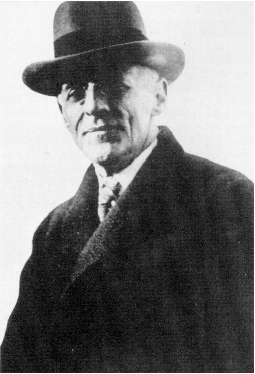 |
| A. Flexner |
|
|
Moreover, many of these 155 medical schools were alternative schools which taught non-traditional medicine such as Osteopathic medicine, Eclectic medicine, Homeopathy, Naturopathy and Physiomedicalism and these practitioners competed vigorously with traditionally-trained physicians.
As result of Flexner’s report and the adoption of higher academic standards, between 1910 and 1935, more than half of all American medical schools merged or closed, leaving 66 surviving medical schools of which 57 were part of a university. By helping enact higher medical school admission, teaching and graduation standards and by making adherence to modern science a cornerstone of medical education Abraham Flexner was able to raise American medical education to match the best education then prevailing in Europe. It is reasonable to state that many aspects and advances of modern American Medicine are the result of Flexner’s Report.
|
| The revolution in American Medicine that followed the publication of the Flexner Report also resulted in the formation of The American Board of Medical Specialties (ABMS) on 6/11/1933. In the 1920’s and 1930’s each American medical specialty formed its own quality overseeing board to set the educational standards and verify
|
training of their specialists practitioners. In 1933, these medical specialty boards joined together forming an umbrella organization, the American Board of Medical Specialties to specialty formed its own quality overseeing board to set the educational standards and verify training of their specialists practitioners. In 1933, these medical specialty boards joined together forming an umbrella organization, the American Board of Medical Specialties to “Protect the public against irresponsible and unqualified practitioners “as well as to “Elevate the standards of their respective specialties” by setting and verifying standards for
|
| physician education. The American Board of Medical Specialties (ABMS) and its various boards, including the American Board of Plastic Surgery (ABPS), became THE pre-eminent entity overseeing the certification of ALL physician specialists in the United States and is comprised of 24 medical specialty boards which represent ALL medical specialties.
These 24 ABMS member boards oversee and issue certifications in more than 145 specialties and subspecialties. More than 700,000 physicians are certified by one or more ABMS Member Board. By 2003, more than >85% of all licensed physicians in the USA were certified by at least one ABMS member board. As a result, specialty board certification from an ABMS member board has become THE requisite gold standard in American Medicine. (To see the 24 member boards of the ABMS, please, click HERE).
|
|
See for yourself. Here are two very educational videos posted on the ABMS website.
|
 |
| GREAT Introuction - HOW TO CHOOSE a DOCTOR |
|
|
 |
| "WHAT YOUR DOCTOR ISN'T TELLING YOU" - NBC |
|
|
A quicktime video overview of how to best go about choosing your doctor
(May need a high speed internet connection)
|
News Chief Medical Editor, Dr. Nancy Snyderman, explaining the importance of choosing a physician with board certification from a Member Board of the American Board of Medical Specialties (ABMS) on the Today Show (01/17/08)
|
|
"Board Certified" has become a SALES BAIT
It is NO longer What you Think it is
|
| As most older Americans can tell you, post-WWII America was prosperous and the Cold War with the Soviet Union and the Space Race (including Mercury, Gemini and Apollo NASA missions) offered huge opportunities in physics and engineering in both the government and private sector. This led to fierce competition for engineering programs. In this post-WW II prosperity, medical discoveries and innovations greatly advanced the capabilities of American Medicine. Americans were healthier and lived longer than ever and their physicians did well. As a result, the competition for medical schools was the fiercest it has ever been.
The amazing success of American Medicine was ironically also the cause of its progressive failure. As American Medicine became unbelievably better, it also became very expensive to maintain. Scientific innovations are costly and for such successes to continue someone must continue to pay for them. But, the government and the medical insurance companies, the entities who have been paying the bills, grew tired of it and began shifting the burden elsewhere. Like a group of frugal, ill-mannered guests after an expensive restaurant meal, the government and the insurance companies began a check dodging game which continues to the present time. (Increasingly expensive policies, higher co-pays, higher deductibles, more regulations, greater delays in approvals and doctor payments etc).
|
The progressive decline of American Medicine began in 1965 with the enacting of Medicare which led to ever increasing and confusing State and Federal regulations. Then, in the 1980’s with the introduction of publically traded HMO’s, American Medicine was reduced to another Wall Street traded commodity. Your doctor was formally changed into a “provider” and you were no longer a patient; You stopped being a patirnt and became a “consumer of health care services”. Doctors’ incomes went into a tail spin from which they never recovered while insurance company CEO’s and Wall Street speculators made billions of dollars on the backs of both the American public and its physicians.
Despite all you read and see on TV, the average medical doctor is not wealthy. Compounding the ever increasing stresses from insurance companies and unprincipled personal injury lawyers coupled with increasing office expenses, doctors’ incomes have been steadily falling and have not even kept up with
|
inflation. To supplement their progressively dwindling incomes some doctors join business ventures while others pursue management and business degrees and go into corporate or administrative positions. Sadly, as you can readily see, many physicians now supplement their incomes by offering whatever the current fads may be such as dietary supplements and unproven therapies (such as Mesotherapy, fat melting lotions, holistic medicine, detoxifying treatments, acupuncture or multivitamins) while some physicians even sell Amway products.
But a large number of physicians has been attracted by the shine of the always-seemingly-greener grass outside the fences of their medical trainings and expertise and have branched out to literally practice outside their fields of training and outside their Scope of Practice (SOP). As a result, now doctors other than obstetricians, deliver babies, doctors other than cardiologists, diagnose and treat heart disease and doctors other than allergists or pulmonologists, treat asthma.
|
 |
| Greener Grass |
|
|
|
The Appearance of Superfluous Commercial “Boards” Since its formation in 1933, the American Board of Medical Specialists (ABMS) has represented and stood for unquestioned excellence in Medicine. For these forty years, the ABMS protected Americans with a steady supply of well- trained, high quality medical specialists covering the whole spectrum of Medicine. As a result, there has never been a need for other copy-cat “boards”. But that was too good to last without economic exploitation by others.
|
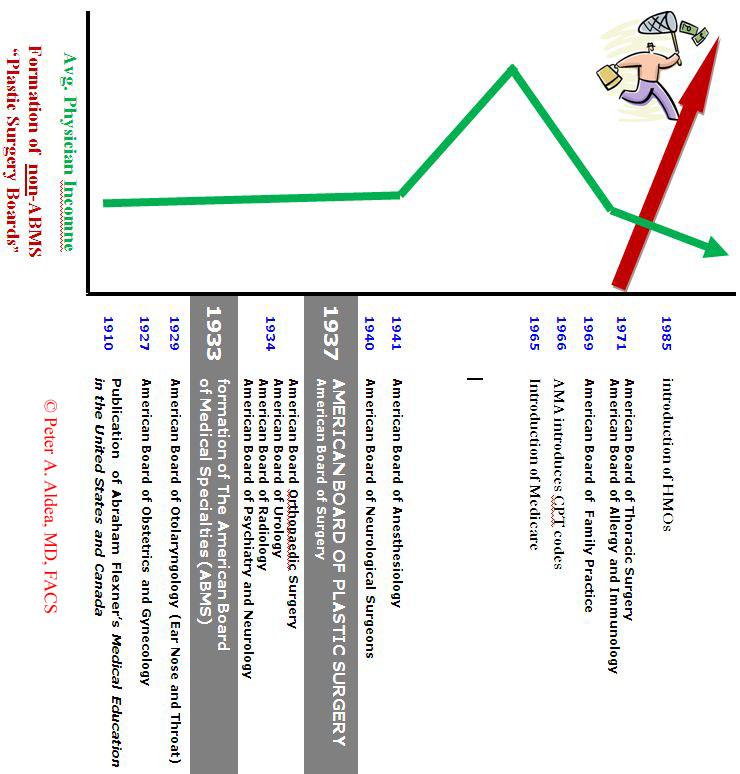 |
| Economics and "Board" Formation |
|
|
Enterprising minds have always come up with innovative ways to fleece the American public. In recent year as economic conditions soured for physicians, multiple duplicative NON-ABMS proprietary “medical boards” sprang up, like mushrooms after the rain, to parasitize and cash in on the 40 year hard-earned reputation of the ABMS and its component medical boards. At last count, the existing 24 ABMS member boards now compete for the respect and the trust of the American public with approximately 180 such non-ABMS, bogus boards whose numbers increase yearly and whose certification standards vary enormously. A recent Google search for “The American Board of” yielded 2,110,000 web pages.
These “boards” have been busily conferring / selling the coveted “board- certified” title to their thousands of well-paying “members”. As a result, the ABMS’ brand of “Board-Certified”, a formerly recognized mark of quality, has been rapidly subverted and largely usurped by these
|
proprietary business interests (aka “boards”), making it impossible to tell real from fake and genuine from wannabee.
One can easily buy fake Rolex watches, Gucci, Kate Spade or Louis Vuitton bags, Nike sneakers or expensive jeans in all our major cities. But now, Medicine and your safety are on sale as well. These new medical “boards” have different certification requirements than the ABMS boards and as a result seemingly any physician could now call himself/herself “Board Certified” as well as list themselves as such in the Yellow Pages or other publicity without the American public fully understanding that they are purchasing a different product.
| |
Seeing a “Board Certified” doctor these days
is like reaching into a “Box of Chocolates”…
|
| Stated another way, unfortunately, “Board-Certified” had now been reduced to an unknown quality and became just another sales bait. Unless your doctor is certified by an ABMS board, you are opening a Forrest Gump box of chocolates and “you never know what you're gonna get”.
Fortunately, with the exception of the unknowing American public, most medical organizations, insurance companies and regulatory agencies (such as The Joint Commission) and other accrediting organizations (such as the National Committee for Quality Assurance (NCQA), Utilization Review Accreditation Commission (URAC) ) know better and do not recognize non-ABMS boards. But - their real intended target, the American public, does NOT know the difference and is frequently taken in by them.
|
For your safety, Find out if your chosen doctor
is certified by an ABMS member board.
If the doctor is not, Look Elsewhere…
The American Board of Medical Examiners (ABMS) website is extremely useful. You can see EACH of its member boards AND find out if your chosen doctor is really certified by one of its 24 medical boards.
|
 |
| Is YOUR Doctor really ABMS-certified AND in WHAT? |
|
|
Is YOUR doctor Certified and in WHAT area of Medicine? To check if YOUR intended doctor is really certified by an ABMS member board click HERE or on the image above.
|
|
So – to be safe, I should just look for an ABMS “Board-Certified” Surgeon, Right? NOT EXACTLY…
| |
Not even all ABMS “Board-Certified” surgeons who practice Plastic Surgery are equal. To confuse the public further, only a minority of physicians practicing Plastic Surgery are totally unlicensed or uncertified by any legitimate medical board. The majority of these Plastic surgery claimants are certified by other legitimate but unrelated ABMS medical boards. But, none of these boards actually evaluate the validity and certify the training and competence of their physicians in the full range of Plastic Surgery (Such as American Boards of Dermatology, Family Practice, Ophthalmology, Otolaryngology (Ear, Nose and Throat), Obstetrics and Gynecology, Oral and Maxillofacial Surgery, Emergency Medicine and American Board of Surgery, among others).
Half a truth is often a great lie
Benjamin Franklin (1706-1790)
US statesman, diplomat, inventor, printer "Poor Richard's Almanac"
The American College of Surgeons (ACS) (www.facs.gov), the umbrella organization overseeing all of the American surgical societies, was founded in 1913 to encourage excellence in Surgery and promote its ethical practice. Its major objective is the welfare of the American public. In its publication Statements on Principles, the ACS restricts its surgeons from routinely performing surgery outside their area of training (outside their SOP) and board certification (i.e. "out of bounds" surgery). Furthermore, the American College of Surgeons clearly defines a "surgical specialist" (including a specialist in Plastic Surgery) as a surgeon who "is certified by an American surgical specialty board approved by the American Board of Medical Specialties".
In other words, the American College of Surgeons, the umbrella organization overseeing all of the American surgical societies, stated that ONLY surgeons certified by the ABMS’ only board of plastic surgery – the American Board of Plastic Surgery (ABPS) – are true surgical specialists.
|
|
“But – my Doctor was “Board-Certified”…
All too often we hear this poignant lament in our office from dissatisfied patients with sub-standard results. They had a procedure by a surgeon who was “board certified” – so why did “this” have to happen to them? The very idea that their “board-certified plastic surgeon” was never an ABPS certified surgeon or an ASPS member, but in reality was a Family Practitioner, a Gynecologist or another non-physician by training, was never disclosed and certainly not even imagined by the vast majority of these unhappy patients.
|
So – to be safe, I should just look for a
“Board-Certified” Plastic Surgeon, Right? NOT EXACTLY…again
| |
You did your homework. Your “Board-Certified” doctor is certified by an ABMS board. Everything looks great. You exhale a deep sigh of relief and feel it is safe to go back into the water, right? Wrong. Not so fast. Unfortunately, only a minority of the American public fully understands the meaning of board certification in Plastic Surgery.
But no other ABMS specialty has been more affected, more encroached upon and more misrepresented than Plastic Surgery. Nowadays, it seems everybody regardless of his/her medical training wants to practice Plastic surgery.
Increasing financial stresses and the utterly false seductive prospect of making “easy” money with “simple” surgery have convinced many non-plastic surgeons and physicians in other specialties, who have been chronically bullied by huge insurance companies and financially hurt by rising operating costs and plummeting insurance reimbursements, that switching to practicing “plastic surgery” was their true life-calling after all.
|
| However, instead of taking the responsible route of formal training in Plastic surgery (see below, under Proper Training) and passing the rigors of true American Board of Plastic Surgery board-certification, the majority of these disillusioned, economic refugees from other specialties abandon their fields of training, take training short-cuts and literally practice “plastic surgery” with little if any training. It is ludicrous to even suggest that our 6-8 years of rigorous, full time training in Plastic surgery and of the preparatory surgical training leading to it, can be picked up in a few weekend seminars, as many of these practitioners do.
These economically driven professional transformations are encouraged, financially rewardedand legitimized by multiple so-called “boards” which have evolved outside the central organization of the American Board of Medical Specialties (ABMS).
|
In reviewing the website of the American Board of Medical Specialties (ABMS), you will NOT find ANY of the these other “boards" of Plastic Surgery so prominently visible in all our Yellow Pages, newspapers and ladies’ magazines. In reality, these organizations are unofficial, often poorly regulated, and frequently commercial ventures, some of which sanction physicians with either unrecognized, or no formal training to "practice" Plastic Surgery.
For a fee, these proprietary “boards” now allow practically any physician to easily misrepresent his/her qualifications to the public by claiming they are “board certified” and cloak themselves with the respectability of impressively sounding NON-ABMS boards.
| |
Due to the sheer frequency of its use and abuse, the term "board-certified" has all but lost its true meaning. The confusing reality is that any American physician (not only surgeons),
|
| who wishes to do so, regardless of his or her actual medical training, can legally "practice" Plastic surgery. (In fact, any physician can also practice brain surgery or heart surgery, but few, if any, physicians are dumb enough to try doing it in their clinics).
There are only approximately 6,000 American Board of Plastic Surgery-certified plastic surgeons in the United States. But there are another 40,000 physicians and others who label themselves as either Plastic or Cosmetic surgeons who practice plastic surgery. The problem is immense. Anyone fresh out of medical school can legally hang up a shingle and take up Yellow Page ads stating that he or she is a plastic or cosmetic surgeon.
To verify if your chosen plastic surgeon is truly an American Board of Plastic Surgery -certified Plastic surgeon, you may call the ABPS at (215) 587-9322.
|
|
Definition of a QUALIFIED Plastic Surgeon
|
• Proper and Complete TRAINING
• CERTIFICATION by the American Board of Plastic Surgery (ABPS)
• MEMBERSHIP in The American Society of Plastic Surgeons (ASPS)
• Maintenance of ABPS CERTIFICATION (MOC)
| |
|
• Proper and Complete TRAINING
|
Plastic Surgery is a surgical super-specialty. To be accepted into their highly competitive training programs, successful applicants must stand out from the others based on their skills, recommendations, clinical achievements and their examination scores. In addition, they have to have completed a preliminary minimum of 3 years of general surgery training, although most commonly, successful applicants had satisfactorily completed formal training and are board admissible or certified in either general surgery, neurological surgery, orthopedic surgery, otolaryngology or urology BEFORE they can begin training in Plastic Surgery. Subsequent training in Plastic Surgery, depending on the program, lasts an additional 2-3 years. As a result, few surgical specialties train for as long as REAL plastic surgeons do. With training lasting between 6 and 8 years after graduating from medical school, only Neurosurgery, Heart Surgery and some other surgical specialties (Pediatric and Transplantation) are as long. (Click HERE to view these requirements on the website of the American Board of Plastic Surgery)
| |
|
A VERY inconvenient Truth for our competitors Those competitors who maintain that their training is equivalent or better than Plastic surgeons are deluded and dishonest. How can their weekend seminars be equivalent to years of learning, training and honing Plastic surgery judgment skills? So next time you see a non-ABPS certified practitioner in consultation or, for Botox and he or she tells you how “extensive” their "Plastic surgery" training was, please, feel free to smile or chuckle.
• American Board of Plastic Surgery
(ABPS) CERTIFICATION
The American Board of Plastic Surgery (ABPS) is THE ONLY REAL (i.e. ABMS board) that certifies Plastic Surgeons
|
| The REAL Plastic Surgery
Board Certification
|
|
|
ABMS Board certification is a proof of a physician’s exceptional expertise in a particular specialty. Despite anything else you may hear or read, one fact is immutable and beyond challenge: the ONLY board truly charged and authorized by the American Board of Medical Specialties (ABMS) to certify Plastic surgeons in the USA in the full range of the art and procedures of Plastic Surgery is the American Board of Plastic Surgery (ABPS). To convince yourself of this fact, please visit and research the official site of the American Board of Medical Specialties (ABMS)
The American Board of Plastic Surgery, an AMBS member board, was founded in 1937, more than four decades before the other “plastic and cosmetic surgery boards” appeared on the medical landscape. The logo of the board is an engraving of Gaspare Tagliacozzi, an innovative 16th Century Italian surgeon, considered to be the father of modern Plastic Surgery.
|
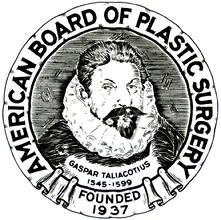 |
| Your Plastic Surgeon SHOULD have Taglicozzi on his/her wall |
|
| Gaspare Tagliacozzi (in Latin, Gaspar Tagliacotius), was a very popular professor of Anatomy and Surgery at the University of Bologna for 30 years. The University of Bologna (Italy) was one of the most famous and oldest medical schools in Europe at that time. (Among its famous alumni are Dante Alighieri, Thomas Becket, Erasmus, Nicholas Copernicus, Paracelsus, Albrecht Dürer, Carlo Borromeo, Berengario da Carpi, Marcello Malpighi, Luigi Galvani and Antonio Maria Valsalva).
Facial deformity and loss of facial parts from dueling, fights, and syphilis were very common in 16th century Europe. Among his surgical talents, Tagliacozzi perfected a
|
technique of nasal reconstruction using a temporary bridge of flesh (i.e. flap) of the inner arm. His became known as a miracle worker and had many patients seek him from all over Europe.
In 1597, Tagliacozzi published the earliest and most famous Plastic Surgery book - De curtorum chirurgia per insitionem. In uibus ea omnia, quae ad huius chirurgiae which described his technique in detail. Although he was very popular with his students and patients, the Church opposed his work on the grounds that man must never undo the will of God. The Church regarded the ravages of syphilis as an act of Divine punishment and regarded Tagliacozzi’s repairs as directly interferring with the handiwork of God. Shortly after Tagliacozzi died in 1599, he was exhumed by the Church and buried in unconsecrated ground because of these perceived transgressions and alleviation of suffering.
To see a nice presentation of Tagliacozzi's work, please, refer to the HISTORY page on this website , scroll to the bottom of the page under The Visual History of Plastic Surgery and click to view Episode 2. You will not regret it.
With the power of the internet, you may even see Tagliacizzi’s De curtorum chirurgia book online . Please, click HERE.
| |
|
• Membership in The American Society of Plastic Surgeons
If you want an easy way to pick a pre-screened, qualified plastic surgeon, pick an ACTIVE MEMBER of the American Society of Plastic Surgeons (ASPS). The ASPS was founded in 1931 and to help its members render the highest quality plastic surgery care while maintaining high professional and ethical standards. Membership in the ASPS is a privilege conferred only on moral, ethical and experienced Plastic surgeons who have met multiple screening criteria. Requirements for membership in the ASPS include board certification by the ABPS, being in the exclusive practice of only Plastic surgery, being recommended by their local Plastic surgery peers, passing a review by the membership committee and being voted in by 80% of all ASPS members.
ASPS members must also continuously participate in continuing education and adhere to a strict and commonly enforced Code of Ethics to protect our patients. No other surgical society has such a code. (You may read the ASPS Code of Ethics by clicking HERE). Furthermore, unlike other societies, the ASPS promotes patient safety. All ASPS members MUST only operate in accredited surgical facilities that have passed rigorous external inspection of equipment and staffing and members demonstrate attending over 20 hours of lectures on patient safety every three years.
Both Dr. Peter Aldea and Dr. Patricia Eby are proud members of the American Society of Plastic Surgeons.
|
| This symbol, the American Society of Plastic Surgeons’ Symbol of Excellence, designates surgeons who are Active members of the American Society of Plastic Surgeons. They are certified by the American Board of Plastic Surgery and are dedicated to the highest standards of patient welfare and surgical excellence.
|
|
• MAINTENANCE OF ABPS CERTIFICATION (MOC)
Unless they move to another state, most professionals, such as accountants, architects or lawyers pass their defining examination(s) once and never have to repeatedly prove their competence by taking it again. This used to be true in Medicine as well. Once you became certified by an American Board of Medical Specialties (ABMS) member board, you had a lifetime board certificate.
But Medicine changes rapidly and the all 24 ABMS boards decided it owed a duty to the American public to make sure that its board-certified members (i.e. diplomats) kept up with the innovations in their specialties. After all, the measure of specialists is not merely that they have been certified, but how well they keep current with advances in their specialties.
In 2006, to formally measure and prove its specialists’ continued competency in their chosen specialties, The American Board of Medical Specialists’ 24 member Boards adopted a program of continuous professional development—Maintenance of Certification (MOC). Starting now, (some) physicians would have to continuously demonstrate their commitment to lifelong learning and ongoing self-assessment by giving proof of continuing medical education courses in between re-certification examinations. Unlike other professions, the ABMS and its member boards, including the American Board of Plastic Surgery (ABPS), instituted MOC and Board re-certification on its members to openly demonstrate to and assure the public of the quality and competence of its medical specialists.
The American Board of Plastic Surgery (ABPS) has implemented the ABMS’ MOC decision a full twelve years earlier in 1994. But - the current Plastic Surgery MOC system is at present glaringly unfair to both the American public and younger plastic surgeons.
In 1994, the American Board of Plastic Surgery issued its last unrestricted, lifetime board certifications. Subsequently, all ABPS board certificates became time limited certificates (TLC’s) with a 10 years’ duration. Starting in 1995, all ABPS certified plastic surgeons now have to repeatedly prove their competence and safety every ten years by submitting a continuous log of their surgical cases to be reviewed for complications, by having letters of recommendation written for them by the several references including chief of Surgery and
|
chief of Plastic Surgery in the hospital where they practice and by passing an all encompassing board re-certification examination. Plastic surgeons who fail this examination lose their board certification status.
On the other hand, due to irreversible legalities, all the older, pre-1995 ABPS certified plastic surgeons (life certificates holders) do not have to pursue MOC and re-certify. They cannot be compelled to demonstrate their fund of knowledge by taking re-certification examinations AND even if they took a re-certification examination and failed it – they could never lose their permanent board certification.
The American Board of Plastic Surgery (ABPS) and the American
| |
Society of Plastic Surgeons (ASPS) represent the vast majority of plastic surgeons in the USA and Canada. Beginning in 2005, owing to a grossly disparate measuring stick application, the ABPS and the American Society of Plastic Surgeons stopped representing a reliably homogenous group of plastic surgeons of proven quality.
1995 is a VERY important cut off year in Plastic Surgery Certification. Only surgeons who became board certified in 1995 and later have to stay current and demonstrate their competence and a vast majority of them do so. On the other hand, plastic surgeons who certified even a year earlier do not have to re-certify and the vast majority of them do so do not even try.
The American Society of Plastic Surgeons (ASPS) is a society which long prided itself on its dedication to patient safety. And yet– owing to political correctness and legalities, the ASPS is now awkwardly misleading the public by presenting all of its surgeon members, regardless of their re-certification status, as being equal. This has caused a persistent dilemma for many of us who expected better.
|
Numerous studies have proven that staying current with the latest medical innovations and proving it by passing recurrent re-certification examinations are associated with better clinical outcomes and increased patient safety. That being the case, it then logically follows that all surgeons should be required to go through MOC and re-certification. But, barring that, in the interest of both fairness to those surgeons who do re-certify and the American public which relies on them, both the ABPS and the ASPS should make a distinction between these two
| |
groups of plastic surgeons. Such distinction, MAY in the least, encourage more surgeons to get involved in the MOC and board re-certification process. At the present time, this is NOT being done.
How does this apply to you? There is NO DOUBT that ASPS members with ABPS certificates dating to 1994 and earlier, who have not gone through MOC and have not re-certified, are by virtue of training, experience and the ASPS membership requirements still a better choice than going to non-plastic surgeons with non-ABMS certification. That being said, while some of them are outstanding plastic surgeons, others may not be. (To borrow computer terminology, in effect, you are using an early version (v1.0) software or operating system rather than the latest version).
|
Board Certified Plastic Surgeons in Memphis, Tennessee
( March 2012)
|
|
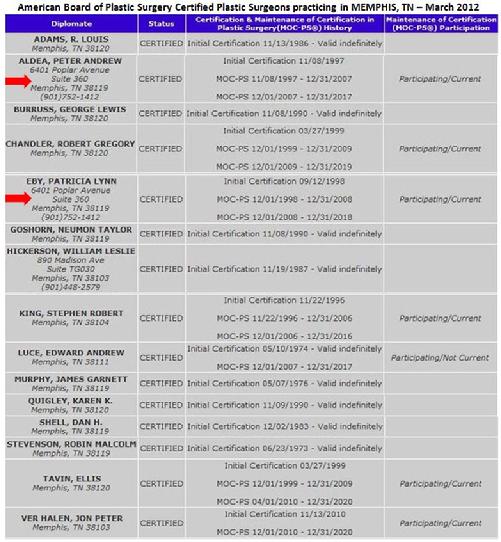 |
| Memphis Board Certified Plastic Surgeons |
|
|
It's really SIMPLE.
If Your Surgeon is not on the ABPLSURG.Org List,
He is NOT Board-Certified
|
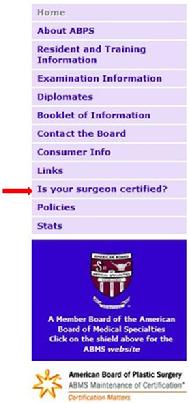 |
| Is your Plastic Surgeon REALLY Board Certified? |
|
| Before seeing any Plastic Surgeon in consultation, much less having a procedure with him or her, please check their credentials here.
In March 2012, Memphis and Germantown, TN had over 30 physicians who practiced Plastic Surgery. Of these, 21 are Plastic surgeons; Surgeons who formally trained in Plastic Surgery prior to going into practice.
But of these, 2 were not certified by The American Board of Plastic Surgery. Of the 19 American Board of Plastic Surgery-certified Plastic surgeons, 11 were certified in 1995 and earlier. As such, these 11 surgeons do not have to go through the scrutiny and rigors of Board RE-Certification and they have not done so.
In summary, of the 21 REAL Plastic surgeons in this area, only 8 are American Board of Plastic Surgery certified and RE-certified Plastic surgeons. Dr. Aldea and Dr. Eby belong to this group.
|
| As a prospective patient, you are entitled to know your surgeon’s education, training and qualifications. Inquire whether your surgeon is board certified and re-certified by the American Board of Plastic Surgery not by a substitute non-ABMS “board”. (It is mind boggling why some people who would cringe at the idea of having a family practitioner or a dentist perform brain surgery on themselves or a family member, would readily submit to such practitioners performing facelifts, breast enlargements, liposuction or vaporizing skin off their faces with lasers).
Another effective way to assure yourself of choosing a competent Plastic surgeon, is to ascertain that he or she has unrestricted Plastic surgery operating privileges
|
to perform your operation in accredited hospitals in your community. You should do so even if your proposed surgery will be performed in the doctor's own surgical facility. Why? To reduce their legal liabilities, all American hospitals closely review and scrutinize applicant doctors’ professional credentials. The hospitals’ review credentials committees then grant privileges, allowing only those surgeons who have demonstrated training, competency, and continued education to perform these specific procedures in their facilities. Moreover, the American Society of Plastic Surgeons (ASPS) requires all its members to maintain hospital privileges in the rare case that a patient may require unexpected hospitalization. If your chosen surgeon does not have unrestricted Plastic Surgery hospital privileges, he/she is NOT a member of the ASPS (big red flag) and, or he/she was considered too much of a risk by the hospital to grant them such privileges (another major red flag).
Finally, whenever picking a Plastic surgeon look for the 3 reliable symbols that reflect training, ethics, safety and keeping current (ABPS,ASPS and MOC). Use the check list on top. It will keep you off the big mines in your path for Plastic Surgery success.
|
Cosmetic surgery is an investment in yourself.
An investment which could make a world of
difference in your outlook.
Peter A. Aldea, M.D. Patricia L. Eby, M.D.
Certified and Re-Certified by The American Board of Plastic Surgery
Members of the American Society of Plastic Surgeons
Fellows of The American College of Surgeons
|
Cosmetic Surgery Specialists of Memphis, PLLC
6401 Poplar Avenue, Suite 360, Memphis, Tennessee 38119
Telephone (901) 752-1412
Use of this site signifies your acceptance of our Terms and Conditions.
No part of this website may be reproduced in any manner (text, graphics or photos) without
the written permission of Peter Aldea, M.D. and Cosmetic Surgery Specialists of Memphis, PLLC.
All Rights Reserved © 1999 Cosmetic Surgery Specialists of Memphis, PLLC
|
|